- What is Neurodermatitis? - (https://nationaleczema.org/eczema/types-of-eczema/neurodermatitis/)
- Self-management - (http://www.mayoclinic.org/diseases-conditions/dermatitis-eczema/manage/ptc-20204515)
- Contact dermatitis - (http://www.mayoclinic.org/diseases-conditions/contact-dermatitis/basics/prevention/con-20032048)
- Slide show: Types of dermatitis - (http://www.mayoclinic.org/diseases-conditions/dermatitis-eczema/multimedia/dermatitis/sls-20076203?s=3)
- What Is Atopic Dermatitis? - (https://www.niams.nih.gov/health_info/atopic_dermatitis/atopic_dermatitis_ff.pdf)
- Prevention of atopic dermatitis - (https://www.ncbi.nlm.nih.gov/pmc/articles/pmc3515944/)
What is Dermatitis?
Dermatitis is a group of skin conditions of varying causes marked by inflammation of the skin, characterized by itchiness, pain, redness and scaly rashes. It often results from contact with allergens or noxious chemicals, or due to infectious pathogens.
Dermatitis can be of various types such as atopic dermatitis, allergic contact dermatitis, irritant contact dermatitis, neurodermatitis, stasis or gravitational dermatitis, and seborrheic dermatitis. The symptoms, treatment, and prevention of the different types of dermatitis are discussed.
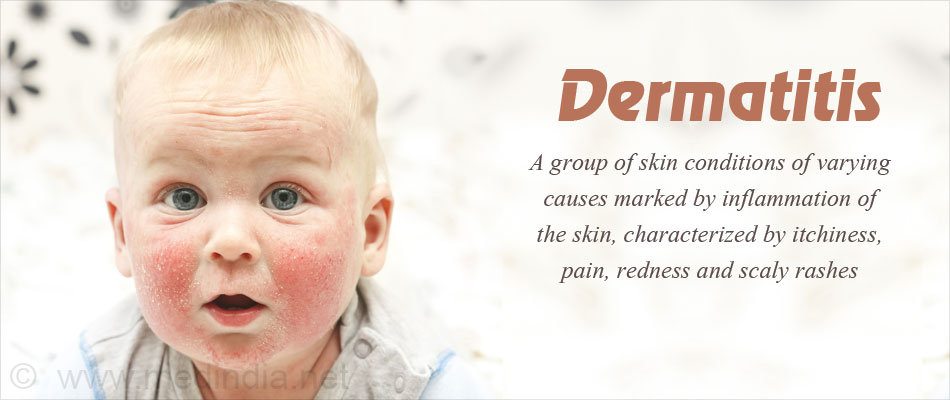
Structure of the Skin
The skin is regarded as the largest organ of the human body and provides a protective covering against environmental agents as well as air- and water-borne pathogens.
The skin consists of three layers:
Epidermis: This is the outermost thin layer of the skin, which is exposed to the external environment. A protective layer made up of the protein keratin is present on it’s surface, which makes the skin tough and resistant to wear-and-tear and provides a waterproof barrier. The epidermis contains melanin pigments, which are responsible for imparting the skin tone. The epidermis does not have any blood vessels.
Dermis: This is a thick layer of epithelial tissue located below the epidermis. It bears numerous hair follicles, sweat glands and sebaceous glands. It is also rich in lymphatic vessels and blood capillaries and is innervated by nerves that impart the sensation of touch.
Hypodermis: This layer is located below the dermis and is not strictly part of the skin, and is made up of fat and loose connective tissue. The fatty layer provides cushioning and insulation for the body. The hypodermis helps to attach the skin to the underlying muscles and supplies the blood vessels and nerves to the upper layers.

The major functions of the skin include the following:
- Protection
- Insulation
- Temperature regulation
- Perception of sensation
- Synthesis of vitamin D
What are the Major Types of Dermatitis?
Dermatitis can be of two types, acute or chronic, based on the duration of the rash. The clinical features of acute and chronic dermatitis are given below:
Acute Dermatitis
- Redness and swelling, usually with indistinguishable margins
- Papules, vesicles and rarely blisters
- Exudation and cracking
- Scaling
Chronic Dermatitis
- All the above features may be present, but usually less vesicular and exudative in nature
- Lichenification i.e. appearance of a dry leathery thickening with increased markings on the skin, following excessive rubbing and scratching
- Scratch marks and fissures on the affected skin
- Hypo- or hyperpigmentation
Dermatitis can be broadly classified into six major clinical types. These are briefly discussed below:
Atopic Dermatitis
This type of dermatitis is also known as eczema and generally affects the inner elbows, back of the knees, face and the neck. It is characterized by periodic flaring, followed by resolving for periods of up to 2-3 years, before flaring-up again.
The cause of this type of dermatitis is not clear, but it has been suggested that genetic factors play an important role. It generally occurs in individuals with a personal or family history of asthma or allergic rhinitis (as in hay fever). It is thought to be a disease of the immune system where the response is inappropriate to the stimulus. It generally starts during infancy or early childhood, but can occur at any age.
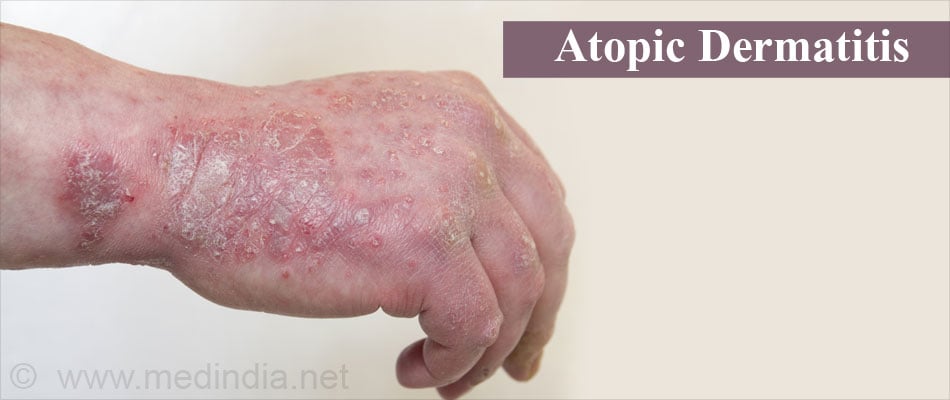
Allergic Contact Dermatitis
This type of dermatitis occurs due to contact with allergens and is usually limited to the area where the allergen comes into contact with the skin. Some common substances that may cause allergic contact dermatitis include certain types of jewelry containing nickel, hair dyes, perfumes, cosmetics, and the plant poison ivy.
Some other examples of allergens and where they are found are given below:
- Dichromate: Cement, leather, matches
- Rubber chemicals: Clothing, shoes, tires
- Colophony: Sticking plaster, collodion
- Paraphenylenediamine: Hair dye, clothing
- Neomycin, benzocaine: Topical creams and ointments
- Parabens: Preservative in cosmetics and creams
- Epoxy resins: Resin-based adhesives
Irritant Contact Dermatitis
This type of dermatitis occurs when the skin comes in contact with irritant substances such as a solvent, disinfectants, detergents, alkalis, acids, cosmetics, bleach, and abrasive dust. The reaction can occur after a single exposure to a strong irritant or by repeated exposures to a weak irritant.
Irritant dermatitis differs from allergic dermatitis in that exposure to a minimum amount of the offending agent is necessary. Allergic dermatitis can occur with exposure to minute quantities of the agent. However both conditions can coexist.
Stasis or Gravitational Dermatitis
This type of dermatitis occurs due to the accumulation of fluids in the lower parts of the legs due to circulatory complications such as the presence of varicose veins. As a result, blood from the peripheral veins returns to the heart with very low efficiency. Moreover, pressure build-up beneath the skin prevents blood and oxygen from reaching the skin layers.
Neurodermatitis
This type of dermatitis is also known as Lichen simplex chronicus, and usually occurs due to repeated scratching. It appears as a single patch either on the scalp, on the back, sides or back of the neck, wrist, forearm, ankle, genitals, and inside or behind the ears. The irritated skin can become thick and wrinkled. Infections may also develop in the irritated parts of the skin. Neurodermatitis is similar to atopic dermatitis as the itchy areas become thick, discolored and marked. However, unlike atopic dermatitis, the specific patches tend to always be present while the rest of skin is healthy.
Seborrheic Dermatitis
This type of dermatitis is found in oily parts of the body such as the scalp, face, eyebrows, sides of the nose, area behind the ears, groin, and center of the chest. It is most commonly found as dandruff on the scalp, which can cause itching. Seborrheic dermatitis causes the skin to fall off as flakes. It is usually caused by a yeast that normally lives on the skin.
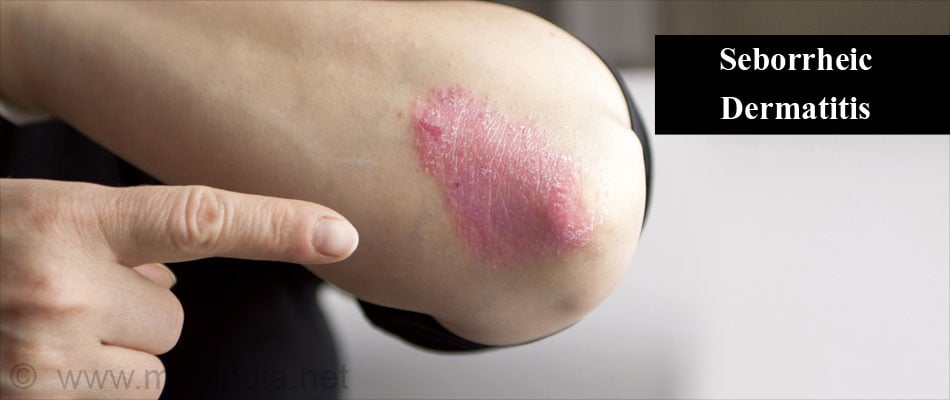
What are the Symptoms of Dermatitis?
While the cardinal symptoms of dermatitis include itchiness, red rashes and swelling, the specific symptoms of the individual types of dermatitis are given below:
Atopic Dermatitis
- Itching, which may sometimes be severe
- Small, fluid-filled blisters
- Red, leathery, crusted or scaly skin patches
Allergic Contact Dermatitis
- Red rashes
- Itching
- Swelling
- Blistering
- Crusting
Irritant Contact Dermatitis
- Red rashes or swelling
- Itching, stinging or burning sensations
- Dry, red patches resembling a burn
Stasis or Gravitational Dermatitis
- Thickened, reddish skin patches on the shins and ankles
- Itching
- Swelling
- Open sores with oozing fluid and crusting
Neurodermatitis
- Itching, leathery or scaly patch of skin in a single limited area
- A raised rough patch that is darker than the rest of the skin
Seborrheic Dermatitis
- Dandruff
- Yellowish crusts on the scalp
- Red scaly skin patches
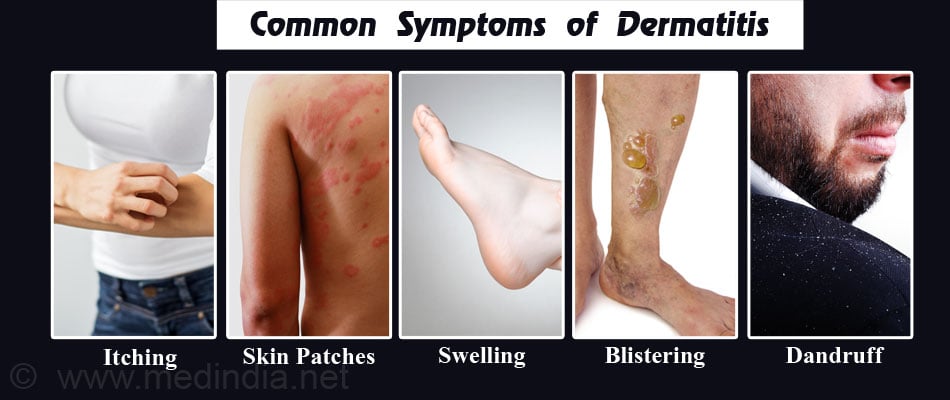
What Investigations are Recommended for Dermatitis?
Patch Test: This test can be carried out in suspected cases of allergic contact dermatitis. Here, a sticky patch impregnated with many allergens in a checkerboard fashion is stuck to the skin of an individual. The appearance of a rash indicates a positive result for the corresponding allergen(s). It should be noted that commercially available pre-prepared patch tests are much more reliable than operator-prepared tests. Steroids should not be used for at least two days prior to the test, as otherwise false negative results will occur.
Prick Test: This test can be performed by taking a minute quantity of the allergen in an injection needle and pricking the skin. This test is useful for detection of specific environmental allergens such as pet dander, horse hair, house dust mite, molds, pollens and food.
Microscopy and Culture: Swabbing the skin to obtain samples for microscopy or culture can detect bacteria or virus that can cause secondary infections. Dermatitis leads to increased susceptibility to infections caused by the bacterium Staphylococcus aureus and herpes simplex virus (HSV).
What is the Treatment for Dermatitis?
General management of dermatitis involves regular use of bland emollients such as emulsifying ointment. They prevent excessive water loss from an already dry skin, thereby reducing the need for topical application of corticosteroids. Emollients are used as a bath additive, a soap substitute and directly onto the skin.
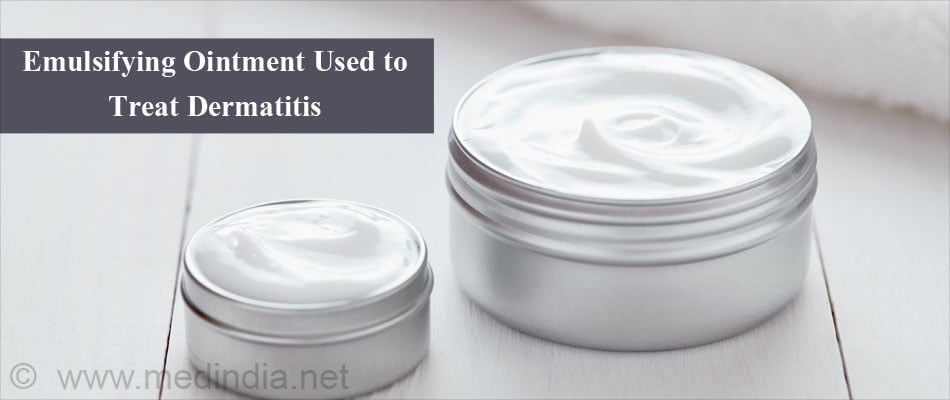
The aim of treatment for dermatitis is symptomatic i.e. controlling the symptoms that arise as a result of the disease condition. The treatment strategy involves management of the itching, swelling and redness, where topical corticosteroids are generally used. Sometimes immunosuppressants are also used. The root cause i.e. the infection is generally managed by antibiotics, usually by the oral route. These treatment strategies are tailored as per the specific type of dermatitis being treated. These are briefly highlighted below:
Atopic Dermatitis
- Moisturizers for preventing dryness
- Immunosuppressant drugs
- Steroid creams and ointments
- Antibiotics for treating the infection
- UV light (alone or with the drug psoralen)
Allergic Contact Dermatitis
- Immediate removal of the allergic substance and thorough washing
- Avoiding future contact with the allergic substance by lifestyle modifications
- Steroid creams for topical application
- Sensitization to topical antibiotics (neomycin) and preservatives (chlorocresol)
Irritant Contact Dermatitis
- Thoroughly washing off the irritant substance
- Avoiding future contact with irritant
- Wearing protective clothing e.g. gloves
- Regular use of emollients
Stasis or Gravitational Dermatitis
- Elevation of the legs
- Steroid creams and ointments for topical application
- Creams and lotions for lubricating the skin
- Antibiotics to treat any infections
- Use of graded compression bandages
Neurodermatitis
- Avoid scratching or rubbing the affected skin
- Use of moisturizers and lubricants to soothe the skin
- Topical corticosteroids
- When steroids are contraindicated, tacrolimus or pimecrolimus is recommended
Seborrheic Dermatitis
- Do not use oil on the scalp or other affected areas
- Shampoo containing zinc pyrithione, selenium sulfide, and salicylic acid
- Antifungal lotions containing ketoconazole
- Steroid lotions
How Can Dermatitis be Prevented?
Some types of dermatitis are easier to prevent than others. Here are some ways to prevent dermatitis:
- Allergic and irritant contact dermatitis can be prevented by avoiding contact with the incriminating allergen / irritant. Wear protective clothing such as gloves if your occupation involves handling these types of substances.
- Wear loose-fitting, natural fiber clothing such as those made of cotton.
- Do not wear plated jewelry, especially earrings, to prevent nickel related contact dermatitis.
- Do not wear watches tightly for long periods, as friction and sweat build-up can produce rashes.
- Moisturize your skin regularly after taking bath by using unscented body lotion.
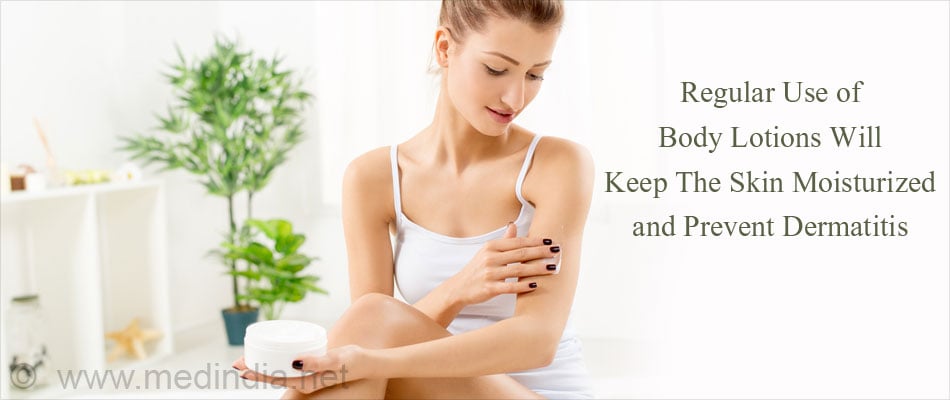
- Use mild detergents for your laundry as the clothes, towels and bed sheets come in contact with the skin. Strong detergents can be carried over and cause rashes.
- Avoid stress since some types of dermatitis can flare-up due to emotional stressors. Practice relaxation techniques such as yoga, meditation and music.
Health Tips to Avoid Dermatitis:
- Use moisturizers regularly: This will prevent the skin from becoming dry.
- Drink plenty of water: Drinking water will help you stay hydrated and keep your skin healthy.
- Take a bath in warm water in winter: Avoid using water that is too hot, as this will encourage dermatitis.
- Avoid wearing imitation jewelry: Opt for jewelry made of gold or silver if possible.









